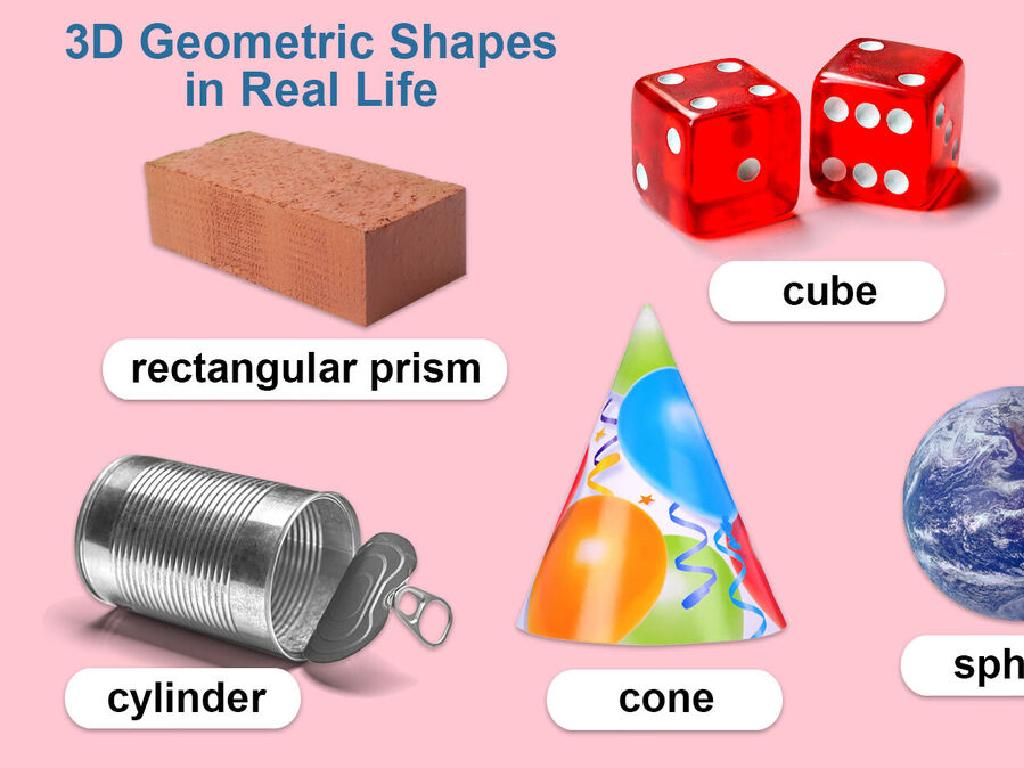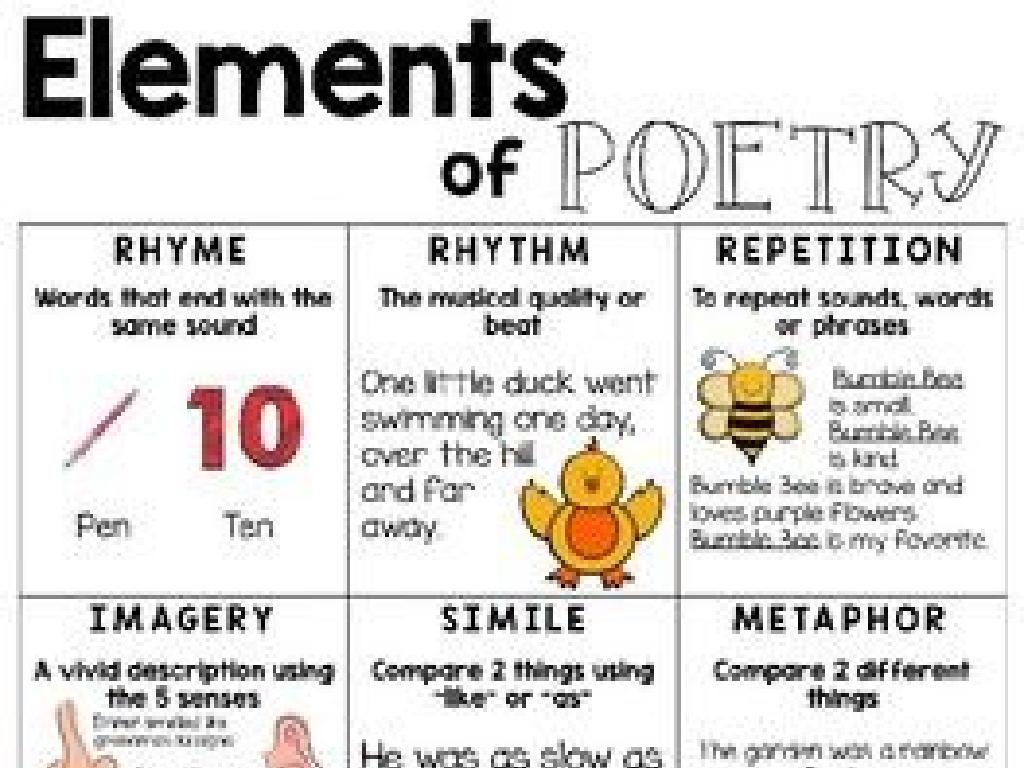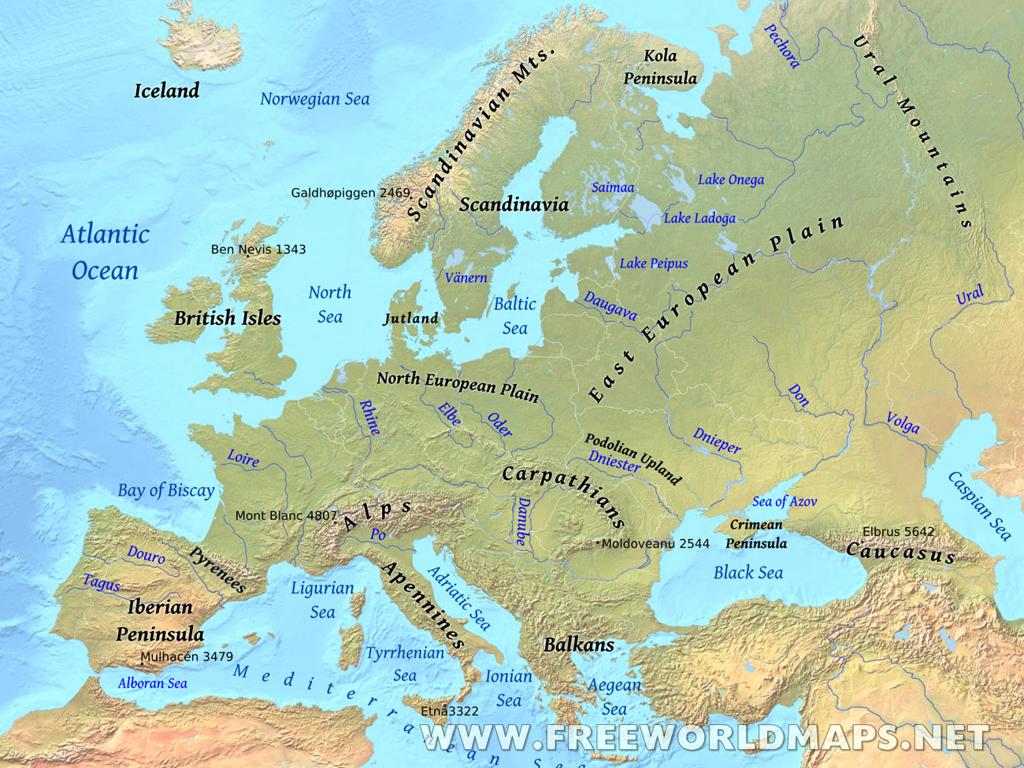Area Of Rhombuses
Subject: Math
Grade: Sixth grade
Topic: Perimeter And Area
Please LOG IN to download the presentation. Access is available to registered users only.
View More Content
Exploring the Area of Rhombuses
– Understanding Perimeter vs. Area
– Perimeter is the boundary length; area is space inside.
– Recap: Perimeter of shapes
– Perimeter is the sum of all sides of a shape.
– Today’s focus: Area of Rhombuses
– A rhombus is a four-sided shape with equal sides.
– Calculating area with diagonals
– Area = (diagonal1 x diagonal2) / 2
|
Begin with a brief review of perimeter, emphasizing that it’s the total distance around a shape, and contrast it with the concept of area, which is the measure of space within a shape. Recap the method of finding the perimeter of various shapes. Then, shift the focus to rhombuses, a type of parallelogram with all sides of equal length. Explain that the area of a rhombus can be calculated using the lengths of its diagonals. Provide examples and practice problems for students to apply the formula for the area of a rhombus. Ensure to clarify that the diagonals of a rhombus intersect at right angles, which is key to understanding why the formula works.
Exploring the Area of Rhombuses
– Define a rhombus shape
– A rhombus is a 4-sided shape with all sides equal and opposite sides parallel.
– Discuss rhombus properties
– Properties include equal opposite angles and diagonals that bisect each other at right angles.
– Real-life rhombus examples
– Examples: Diamonds, kites, and certain windows.
– Calculating rhombus area
– Area = base x height or using diagonals, Area = (d1 x d2) / 2.
|
This slide introduces students to the concept of a rhombus and its geometric properties. Start by defining a rhombus as a type of polygon that is a quadrilateral with all sides of equal length. Highlight the properties such as equal opposite angles and diagonals that intersect at right angles. Provide relatable examples from everyday life where rhombuses can be seen, like in the shape of diamonds or kite designs. Conclude with the formula for calculating the area of a rhombus, ensuring to explain the terms base, height, and diagonals. Encourage students to visualize by drawing a rhombus and labeling its properties. This will prepare them for the next step of calculating the area of rhombuses in various contexts.
Calculating the Area of a Rhombus
– Area formula: base × height
– The area is found by multiplying the length of the base by the height.
– Base: one side of the rhombus
– The base is any side’s length since all sides are equal.
– Height: perpendicular to the base
– Height is the vertical line from the base to the opposite side.
– Practice with examples
– Use different rhombus shapes to apply the formula.
|
This slide introduces the formula for calculating the area of a rhombus, which is the product of the base and the height. It’s crucial to clarify that the base can be any side of the rhombus, as all sides have equal length. The height is the shortest distance from the base to the opposite side, forming a perpendicular. Provide clear examples on the board, showing different orientations of a rhombus to illustrate that regardless of how it is positioned, the method to find the area remains the same. Encourage students to practice with rhombuses of various sizes and to verify their understanding by solving problems in class.
Calculating Area of a Rhombus
– Understand the rhombus shape
– Given: Base = 5 cm, Height = 3 cm
– Formula for Area: Base × Height
– Area is the space inside the shape
– Calculate: 5 cm × 3 cm = 15 cm²
– Multiplying base by height gives the area
|
This slide is aimed at teaching students how to calculate the area of a rhombus. Start by ensuring that students can identify a rhombus and understand its properties, such as having all sides of equal length and opposite sides being parallel. Introduce the formula for the area of a rhombus, which is the base multiplied by the height. Use the given example of a rhombus with a base of 5 cm and a height of 3 cm to demonstrate the calculation. The result is 15 square centimeters. Emphasize that the unit of area is always in square units. Encourage students to practice with different measurements and to check their understanding by solving additional problems.
Calculating Area of a Rhombus
– Rhombus with 6 cm and 8 cm diagonals
– Use diagonals to find area
– Diagonals intersect at right angles
– Area formula: (d1 × d2) / 2
– d1 and d2 are the lengths of the diagonals
– Calculated area: 24 cm²
– Multiply 6 cm by 8 cm, then divide by 2
|
This slide provides an example of calculating the area of a rhombus using the lengths of its diagonals. The formula for finding the area is (diagonal1 × diagonal2) / 2. In this case, the diagonals are 6 cm and 8 cm. It’s important to note that the diagonals of a rhombus bisect each other at right angles, which is why this formula works. After multiplying the lengths of the diagonals, we divide by 2 to find the area, which in this example is 24 cm². Make sure to emphasize that the diagonals are perpendicular, and this property is unique to rhombuses, which allows us to use this method for calculating the area.
Practice Problems: Area of Rhombuses
– Problem 1: Base 4 cm, height 5 cm
– Area = base x height. Calculate: 4 cm x 5 cm
– Problem 2: Diagonals 10 cm and 12 cm
– Area = (d1 x d2) / 2. Calculate: (10 cm x 12 cm) / 2
– Discuss solutions with a partner
– Understand the area calculation
– Why do these methods work for finding the area?
|
This slide presents two practice problems for students to apply their knowledge of calculating the area of rhombuses. For Problem 1, students will use the formula Area = base x height to find the area. For Problem 2, they will use the formula involving diagonals, Area = (diagonal1 x diagonal2) / 2. After attempting the problems individually, students should discuss their solutions and methods with a partner to reinforce their understanding. The teacher should circulate the room to assist and encourage discussion. Possible activities include creating rhombuses with different measurements, using manipulatives to visualize the area, and comparing the area of a rhombus to other shapes.
Class Activity: Exploring Rhombus Area
– Craft your own rhombus
– Measure sides and diagonals
– Use a ruler to measure accurately
– Calculate the area
– Area = (d1 x d2) / 2, where d1 and d2 are diagonals
– Present your rhombus and area
|
In this hands-on activity, students will create their own rhombus using materials like cardstock or construction paper. They will then use a ruler to measure the lengths of the diagonals. Students will apply the formula for the area of a rhombus, which is half the product of its diagonals, to calculate the area of their rhombus. Encourage precision in measurement and calculation. Afterward, students will present their rhombus, explaining their process and findings. For the teacher: Prepare materials in advance and consider creating a worksheet with step-by-step instructions. Have a few examples ready to show, and be prepared to assist students who may struggle with measuring or calculations. Possible variations of the activity could include using different units of measurement or comparing the areas of multiple rhombuses created by the students.
Wrapping Up: Area of Rhombuses
– Recap of rhombus area lesson
– Homework: 3 rhombus-shaped objects
– Find items like a kite or a diamond-shaped sign
– Calculate areas of these objects
– Use the formula: Area = base * height
– Study for upcoming area quiz
|
As we conclude today’s lesson on the area of rhombuses, remind students of the key points and the formula for calculating the area. For homework, students should find three objects at home that resemble a rhombus and apply the formula to calculate their areas. This practical exercise will help reinforce their understanding. Encourage creativity in finding rhombus-shaped objects. Lastly, inform students that there will be a quiz on the area in the next class, so they should review their notes and practice problems to prepare.






